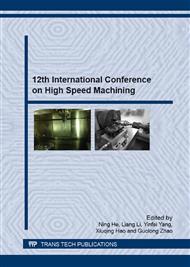[3]
Crafoord, R., Kaminski, J., Lagerberg, S., Ljungkrona, O., Wretland, A., Chip control in tube turning using a high-pressure water jet, Proc. IMechE Part B, 1999, 213/8, pp: 761-767.
DOI: 10.1243/0954405991517191
Google Scholar
[4]
Sharman, A.R.C., Hughes J.I., Ridgway K., Surface integrity and tool life when turning Inconel 718 using ultra-high-pressure and flood coolant systems, Proceedings of the Institution of Mechanical Engineers, Part B: Journal of Engineering Manufacture, 2008, 222: 653-664.
DOI: 10.1243/09544054jem936
Google Scholar
[5]
Kaminski, J., Alvelid, B., Temperature reduction in the cutting zone in water-jet assisted turning, Journal of Materials Processing Technology, 2000, 106: 68-73.
DOI: 10.1016/s0924-0136(00)00640-3
Google Scholar
[6]
Ezugwu, E. O., Bonney, J., Effect of high-pressure coolant supply when machining nickel-base, Inconel 718, alloy with coated carbide tools. In: Journal of Materials Processing Technologie, 153-154 (2004) 1045-1050.
DOI: 10.1016/j.jmatprotec.2004.04.329
Google Scholar
[7]
Mazurkiewicz, M., Kubala, Z., Chow, J., Metal Machining With High-Pressure Water-Jet Cooling Assistance - A New Possibility, Journal of Engineering for Industry, 111/7 (1989).
DOI: 10.1115/1.3188736
Google Scholar
[8]
Klocke, F., Lung, D., Cayli, T., Sangermann, H., Krämer, A., Potential of Modern Lubricoolant Strategies on Cutting Performance, Key Engineering Materials, 554-557 (2013) 2062-(2071).
DOI: 10.4028/www.scientific.net/kem.554-557.2062
Google Scholar
[9]
Ezugwu, E. O., Machado, A. R., Pashby, I. R., Wallbank, J., The Effect of High-Pressure Coolant Supply When Machining a Heat-Resistant Nickel-Based Superalloy. In: Lubrication Engineer, 47 (1990) 751-757.
DOI: 10.1080/10940349808945655
Google Scholar
[10]
Braham, T., Germain, G., Robert, R.; Lebrun, J.L., Auger, S., High-pressure water jet assisted machining of duplex steel: Machinability and tool life. 12th CIRP Conference on Modelling of Machining Operations, Donostia-San Sebastiân, Spanien, 7. -8. Mai (2009).
DOI: 10.1007/s12289-010-0818-9
Google Scholar
[11]
Machado, A. R., Wallbank, J., The effects of a high-pressure coolant jet on machining, Proc. IMechE, 208 (1994) 29-38.
Google Scholar
[12]
Crafoord, R., Kaminski, J., Lagerberg, S., Ljungkrona, O., Wretland, A., Chip control in tube turning using a high-pressure water jet, Proc. IMechE Part B, 213 (1999) 761-767.
DOI: 10.1243/0954405991517191
Google Scholar
[13]
Sharman, A.R.C., Hughes J.I., Ridgway K., Surface integrity and tool life when turning Inconel 718 using ultra-high-pressure and flood coolant systems, Proceedings of the Institution of Mechanical Engineers, Part B: Journal of Engineering Manufacture, 222 (2008).
DOI: 10.1243/09544054jem936
Google Scholar
[14]
Palanisamy, S., McDonald, S.D., Dargusch, M.S., Effects of coolant pressure on chip formation while turning Ti6Al4V alloy, International Journal of Machine Tools and Manufacture, 49 (2009) 739-743.
DOI: 10.1016/j.ijmachtools.2009.02.010
Google Scholar
[15]
Klocke, F., Sangermann, H., Krämer, A. and Lung, D., Influence of a high-pressure lubricoolant supply on thermo-mechanical tool load and tool wear behaviour in the turning of aerospace materials, Proc. IME B J. Eng. Manufact., 225/1 (2011) 52-61.
DOI: 10.1177/09544054jem2082
Google Scholar
[16]
Kaminski, J., Ljungkrona, O., Crafoord, R., Lagerberg. S., Control of chip flow direction in high-pressure water jet-assisted orthogonal tube turning, Journal of Materials Processing Technology, 214 (2000) 529-534.
DOI: 10.1243/0954405001518224
Google Scholar
[17]
ISCAR Germany GmbH, Effizienz im Schneidprozess und Hochdruckkühlschmierung bei der Bearbeitung von Sonderwerkstoffen, Fräsen + Bohren, 2010, pp: 32-37.
Google Scholar
[18]
Khan, A. A.; Ahmed, M. I., Improving tool life using cryogenic cooling. In: Journal of Materials Processing Technology., 196 (2008) 149-154.
DOI: 10.1016/j.jmatprotec.2007.05.030
Google Scholar
[19]
Sangermann, H., Hochdruck-Kühlschmierstoffzufuhr in der Zerspanung, Apprimus Verlag, Aachen. (2013).
Google Scholar
[3]
A liquid wedge is formed which effectively cools and lubricates the cutting zone, leading to reduced tool wear, which is an optimum prerequisite to increase the cutting speed. Sharman has shown that the conventional flood cooling is effective to extend tool life when cutting at low speed and cutting easy to machine materials. In machining difficult-to-cut materials with increased cutting speed, higher cutting temperatures are generated.
DOI: 10.1504/ijmmm.2021.10041169
Google Scholar
[4]
Some researchers report that the high temperatures at the cutting zone cause the lubricoolant to vaporise and to generate a vapour barrier which, during conventional lubricoolant supply, prevents effective cooling of the tool in the region of the cutting edge.
Google Scholar
[5]
By using high-pressure lubricoolant supply, the vapour barrier may be displaced, enabling the lubricoolant to get closer to the cutting edge, thus leading to enhanced cooling of the tool [5, 6]. Furthermore, the mechanical jet force acting on the chip's underside acts as a liquid chip former reducing the upward bending radius of the chip. As a result, the tool-chip contact zone is reduced by up to 50% in comparison to the conventional flood cooling [3, 7, 9]. The chip bending can be influenced by the hydraulic jet force, which mainly depends on the lubricoolant supply pressure and flow rate [3, 10, 11]. In dependence of the predominant conditions it must be prevented that the flowing chip respectively chip fragments captured by the high-pressure jet do not collide with the newly generated workpiece surface that may be damaged in this way. This undesirable effect can be influenced by the geometrical jet alignment and the jet force point of impact [5, 12]. However, it has to be taken into consideration that the tool-chip contact length decreases when using the rake face sided supply variant. If the tool-chip contact area is reduced too much, the generated temperature and mechanical load will act on a small area close to the cutting edge and lead to an increased specific tool load that may result in cutting edge break-outs [7, 8]. Dahlman and Kaminski have shown, that it is possible to achieve a 40% reduction in tool temperature by the use of HP-lubricoolant supply compared to conventional flood cooling [5, 13]. The shorter contact length and reduced friction in this area also result in a larger shear plane angle and reduced chip compression, proving that chip formation is significantly influenced by the high-pressure lubricoolant supply.
Google Scholar
[18]
Moreover, Palanisamy et al. detected that the application of lubricoolant below a pressure of 90 bar in turning titanium alloys results in increased frequency of chip serration, shear-band thickness and average chip thickness compared to a pressure of 6 bar.
Google Scholar


